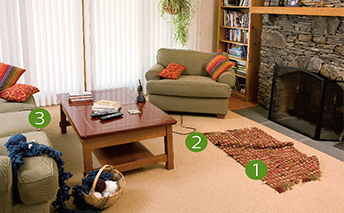In order for the senior population to live independently at home and maintain a high quality of life, any potential fall risk factors should be identified and addressed. Through the normal loss of muscle and speed of movement accompanied with aging, the elderly are more susceptible to loss of balance and significant injury. In a 2010 Center for Disease Control study, it was reported that one in every three adults age 65 and older falls. Falls can lead to moderate to severe injuries, such as hip fractures and head traumas, and can even increase the risk of early death. Fortunately, falls are a public health problem that is largely preventable.
Here are four important ways decrease risk of falls:
1. Home Evaluation: A qualified home health professional such as a physical therapist can help identify and resolve living situations that pose fall hazards. Such things as loose carpeting, throw rugs, narrow and cluttered passage ways can cause an individual to trip and lose balance. There should be room for the individual and assistive device such as cane or walker to easily move through doorways and around furniture. In addition, proper lighting at night is necessary for safely getting up from bed to use the bathroom. Leave a night light on and make sure that you wait for any dizziness to resolve upon sitting or standing up. Wiping up spills quickly and use of proper footwear will also aid in keeping good traction. Floors should be wax-free and non-slip mats should be used in the bath. Lace-up shoes with ankle support are better than slippers or slip-on shoes. Adaptive equipment such as raised toilet seats, grab bars, hand held showers, tub and shower seats, bed rails and arm chairs all may be helpful in keeping an individual safe and more independent.
2. Posture and Gait Corrections: Forward bent posture is very common due to changes in the spine and because of low back conditions such as lumbar stenosis, arthritis and scoliosis. If an assistive device is needed, it should be used and not left behind. People who are reaching out for walls or furniture are prime candidates for fall prevention interventions. In my experience, the walls and furniture are never quite close enough and over-reaching causes a person to get off balance. Proper gait and postural corrections should be made and reinforced until the individual is independent with the corrections.
3. Core Strengthening: The core is the midsection of the body and includes the Abdominal and Lumbar muscles, pelvic floor muscles and Longissimus Thoracis. According to Wikipedia, Dynamic Core Stability is the body’s ability to maintain balance while moving an extremity. An example of this would be to keep balanced and good posture while walking on a slope. Keeping a strong core will help keep upper body stable during standing, reaching activities and upper and lower body stable with dynamic standing activities such as walking, squatting, bending and transferring sit to stand.
4. Daily Exercise: According to the Mayo Clinic, Physical activity can go a long way toward fall prevention. With your doctor’s OK, consider activities such as walking, water workouts or tai chi — a gentle exercise that involves slow and graceful dance-like movements. Such activities reduce the risk of falls by improving strength, balance, coordination and flexibility. If you avoid physical activity because you’re afraid it will make a fall more likely, tell your doctor. He or she may recommend carefully monitored exercise programs or refer you to a physical therapist. The physical therapist can create a custom exercise program aimed at improving your balance, flexibility, muscle strength and gait.

